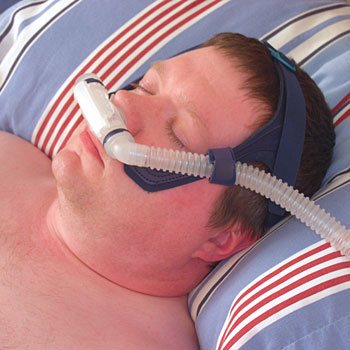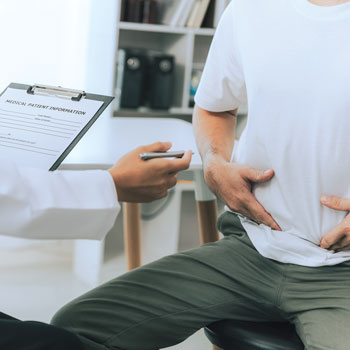Obesity hypoventilation syndrome often overlooked
The condition is likely to show up more often in primary care as rates of obesity in the United States climb.
As rates of obesity climb in the United States, primary care clinicians are likely to also see more patients with obesity hypoventilation syndrome (OHS), a severe obesity-induced respiratory condition characterized by nonspecific symptoms that may include daytime sleepiness, sleep disturbance, or sometimes shortness of breath.
“We don't know the true prevalence because it's underrecognized and underdiagnosed. On top of that, it's rising due to the obesity pandemic,” said Julie Neborak, MD, a pulmonary, critical care, and sleep medicine specialist and assistant professor in the department of internal medicine at Rush University in Chicago. “If you're an internist, you're going to see it.”

A new analysis, published in The Lancet in November 2024, found that in 2021 about 172 million U.S. adults had overweight or obesity, with rates steadily rising over the last 30 years. The researchers forecast that an additional 41.4 million adults will develop overweight or obesity by 2050.
While the current rates of OHS in the general population are not known, the prevalence is between 8% and 20% among patients with obesity who were referred to sleep centers for an evaluation of sleep-disordered breathing, according to the 2019 American Thoracic Society (ATS) Clinical Practice Guideline for OHS.
Diagnostic criteria
One of the reasons OHS can be overlooked is the complexity of the diagnosis, which is not picked up through routine testing. The diagnostic criteria, according to the guideline, are:
- obesity, defined as a body mass index (BMI) of at least 30 kg/m2,
- sleep-disordered breathing diagnosed through polysomnography or home sleep apnea testing,
- awake daytime hypercapnia, defined as partial pressure of carbon dioxide (PaCO2) of at least 45 mm Hg and diagnosed through an arterial blood gas, and
- exclusion of other causes of hypoventilation, such as chronic obstructive pulmonary disease (COPD) and neuromuscular conditions.
“Even if you happen to realize that somebody in your primary care clinic has hypercapnia, there's this whole other workup that has to go on to exclude interstitial lung disease, severe obstructive airway disease, neuromuscular disease, and thoracic cage abnormality, before you can really clinch that diagnosis of OHS,” said Kara Dupuy, MD, a pulmonary and sleep medicine specialist at the Mayo Clinic in Rochester, Minn.
Symptoms also tend to be nonspecific, explained Alvin Chung, MD, chief sleep medicine fellow at Temple University Hospital in Philadelphia. Patients with OHS often report that they are sleepy and more short of breath than usual. There's no “slam dunk” symptom to indicate OHS, he said.
But class III obesity (BMI >40 kg/m2) is one thing that should always put the condition on primary care clinicians' radar, especially if the person has respiratory limitations, since any type of ventilatory insult, such as pneumonia, could result in respiratory failure and ICU hospitalization, said Sanjay R. Patel, MD. One test to consider is a serum bicarbonate level, which can be assessed as part of a routine blood panel. A normal result (<27 mEq/L), even in patients with obstructive sleep apnea (OSA), can exclude a diagnosis of OHS, said Dr. Patel, who is a professor of medicine, epidemiology, and clinical and translational science at the University of Pittsburgh and medical director of the UPMC Comprehensive Sleep Disorders Program.
“There are lots of reasons why a bicarbonate abnormality may be there, like diuretic use,” Dr. Patel said. “It's not a sensitive marker, but it's specific.” If a patient's elevated serum bicarbonate level can't be explained by other factors, it's time to consider a workup for OHS, he said. Serum bicarbonate level should also be considered during preoperative evaluation, since underlying OHS may predispose patients to complications and respiratory failure following surgery, he said.
Looking at the patient's oxygen level can also provide some information about possible OHS, Dr. Dupuy said. Patients with OHS while awake may have an oxygen level that is in the low-normal range, around 91% to 92%. “It's not so low that you would need to treat them but lower than you would think it should be,” she said. That provides another indication to order an arterial blood gas or refer the patient for a sleep study, she said.
“All of this requires you to have a high index of clinical suspicion for the disorder, so it's not always obvious,” Dr. Dupuy said.
OHS and OSA
About 90% of patients with OHS have co-occurring OSA and 70% have severe OSA, according to the ATS guideline. But the connection between OHS and OSA is not fully understood because of a lack of natural history and longitudinal studies, explained Dr. Patel, who wrote a 2019 In the Clinic article on OSA that was published in Annals of Internal Medicine.
“A common belief is that in a subset of people with severe obstructive sleep apnea, there is an adaptation in the body to retain serum bicarbonate in response to the intermittent elevations in carbon dioxide levels with repetitive airway obstructions at night. As a result of this compensation, the next morning, the drive to blow down carbon dioxide levels is not as strong and slowly over time the daytime carbon dioxide levels rise,” Dr. Patel said. “For the vast majority of people, obstructive sleep apnea is probably a predisposing condition that sets off the pathway to develop obesity hypoventilation syndrome.”
There is little information about the 10% of patients with OHS who don't have OSA and instead have nonobstructive, sleep-dependent hypoventilation. “There's just not enough research to really understand what is different about those people,” he said.
While recognizing OSA in primary care can go a long way toward improving OHS, there are also not enough data to determine whether catching OHS earlier in patients with OSA can help reduce adverse outcomes, Dr. Patel noted.
“Obviously, if we could have done something to prevent those patients from ending up in the ICU that would be great, but we're just not clear because of the lack of longitudinal studies [on] how those patients had been in the year before and whether a primary care physician could have identified them,” he said.
Treatment
The ATS guideline suggests that stable ambulatory patients with OHS and severe OSA should receive CPAP as first-line treatment. Patients who are hospitalized with respiratory failure and have a diagnosis of suspected OHS should receive noninvasive ventilation, such as bilevel positive airway pressure (BiPAP), until undergoing testing in a sleep laboratory, the guideline suggested. Weight management is also suggested as part of the OHS treatment strategy.
Treatment escalation may be necessary if patients are adherent to CPAP but are still experiencing CO2 retention. In that case, BiPAP makes sense, Dr. Patel said. “It probably takes about three months to assess whether people are reasonably adherent and assess the impact that [CPAP] is having. I don't think there's great data on when that switch should be made,” he said. For some patients, it may make sense to switch to BiPAP earlier since that treatment can be more comfortable in some cases and may therefore improve adherence, he added.
If left untreated, OHS can have serious health consequences, such as pulmonary hypertension and right-heart failure. Some patients are misdiagnosed as having COPD or asthma, don't receive appropriate treatment, and end up in the ICU, Dr. Neborak said. Other patients who go untreated have a low respiratory reserve, so an acute illness, such as pneumonia, can cause them to develop respiratory failure.
It's also important to look for potential OHS during transition-of-care visits, Dr. Chung said. Patients who have been discharged from the hospital with a diagnosis of acute-on-chronic hypercapnic respiratory failure may have OHS that was missed in the inpatient setting, for example. Some signs that should raise suspicion of OHS in these patients include having obesity, a diagnosis of OSA, or evidence of right-heart failure, or being fatigued and short of breath. “All of these symptoms ring alarm bells,” he said.
Treatment of sleep-disordered breathing has typically come first in OHS because it helps stabilize patients and provide symptom relief, but also because significant weight loss has been so difficult to achieve. Most people with OHS have a BMI above 40 kg/m2, and substantial weight loss is required to reduce or resolve symptoms. For example, the ATS guideline suggests interventions that yield sustained weight loss of 25% to 30%.
Until recently, that could usually only be accomplished through intense multicomponent lifestyle intervention or bariatric surgery, but FDA approval of glucagon-like peptide-1 (GLP-1) receptor agonists for weight loss has opened up new options. Dr. Dupuy said that treatment of sleep-disordered breathing is still high priority but that GLP-1 receptor agonists potentially have a role to play.
“Patients should be treated universally [for sleep-disordered breathing] upfront, but definitely a discussion about weight loss is appropriate,” she said, “because what we know about weight loss so far seems to suggest that it can actually reverse the condition.”



